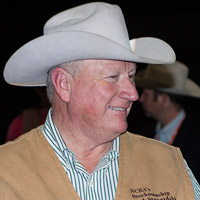Lessons in Stockmanship
Cattle-handling experts give lessons in proper stockmanship.
NASHVILLE, Tenn. (Feb. 4, 2014) — Maintaining the quality and safety of beef through producer education is the focus of the Beef Quality Assurance (BQA) Program. Accordingly, training in stockmanship and stewardship was offered during the 2014 Cattle Industry Convention in Nashville, Tenn.

Curt Pate
“Everything we do to be better stockmen is important,” said cattle-handling clinician Curt Pate, who teamed with Texas AgriLife Extension Educator Ron Gill to conduct a live cattle-handling demonstration.
“Cattle handling is part of managing the cattle environment. When you step into the pen with cattle, you become a part of their environment,” emphasized Pate. “You need to have the right attitude, and you need to have your facilities set up so you have confidence that what you are going to do will work.”
Gill said that doesn’t mean working facilities have to be fancy, but they need to be safe for the animals and the handlers. They will work best if they also allow the handler to take advantage of the animals’ natural behavior. Low-stress cattle handling promotes a more desirable outcome whenever cattle have to be moved or processed.
“Keeping cattle calm is important to the success of an immunization program or when administering treatment for disease. It’s also better for the handler’s health,” quipped Gill.
Pate and Gill demonstrated how to use an animal’s balance point to elicit movement. Showing how to apply and release pressure, they showed the audience how to guide animals, singly or as a group, in a desired direction when sorting or putting cattle through a processing system.

Ron Gill
Gill also discussed proper handling and administration of vaccines or injectable antimicrobial products. He advised producers to keep vaccines cool and away from sunlight while working chuteside. He warned against the use of disinfectants when cleaning syringes, and emphasized proper administration of injectable products.
“Injections should be given in the neck and multiple injections should be spaced at least 4 inches apart, especially products delivered intramuscularly (IM). Subcutaneous (subQ) injections can also be administered in front of the shoulder or in the dewlap,” said Gill, noting that injections in the hip or rump are apt to cause lesions that remain in beef muscle cuts at slaughter.
“A lot of cow-calf producers mistakenly believe that lesions aren’t going to occur when injecting baby calves. It can happen, though, and a lesion lasts for the life of the animal,” Gill warned.
Gill also noted how producers using injectable products for synchronized artificial insemination (AI) sometimes give those injections in the hip. They think it’s easier, he added, but they’re forgetting that those heifers or cows will eventually go into the food chain.
“There’s no excuse for giving an injection in a muscle cut,” stated Gill.
Editor’s Note: The above article was written under contract or by staff of the Angus Journal. It may not be reprinted without express
permission of the Angus Journal. To request reprint permission, contact the editor at 816-383-5200.
www.4cattlemen.com is an event coverage site provided by the Angus Journal editorial team,which publishes the Angus Journal, the Angus Beef Bulletin, the Angus Beef Bulletin EXTRA and the Angus Journal Daily. For questions about this site, to submit an article for our consideration, or to report a broken link, contact the editor at 816-383-5200; 3201 Frederick Ave., Saint Joseph, MO 64506.
The Angus Journal claims copyright
to this website as presented. We welcome educational venues and
cattlemen to link to this site as a service to their audience.

